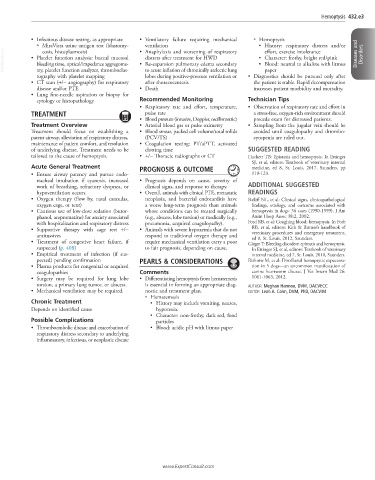Page 893 - Cote clinical veterinary advisor dogs and cats 4th
P. 893
Hemoptysis 432.e3
• Infectious disease testing, as appropriate • Ventilatory failure requiring mechanical ○ Hemoptysis
ventilation
○ MiraVista urine antigen test (blastomy- • Anaphylaxis and worsening of respiratory ■ History: respiratory distress and/or
VetBooks.ir • Platelet function analysis: buccal mucosal • Re-expansion pulmonary edema secondary ■ ■ Character: frothy, bright red/pink Diseases and Disorders
cosis, histoplasmosis)
effort, exercise intolerance
distress after treatment for HWD
Blood: neutral to alkaline with litmus
bleeding time, optical/impedance aggregome-
try, platelet function analyzer, thromboelas-
paper
tography with platelet mapping to acute inflation of chronically atelectic lung • Diagnostics should be pursued only after
lobes during positive-pressure ventilation or
• CT scan (+/− angiography) for respiratory after thoracocentesis the patient is stable. Rapid decompensation
disease and/or PTE • Death increases patient morbidity and mortality.
• Lung fine-needle aspiration or biopsy for
cytology or histopathology Recommended Monitoring Technician Tips
• Respiratory rate and effort, temperature, • Observation of respiratory rate and effort in
TREATMENT pulse rate a stress-free, oxygen-rich environment should
• Blood pressure (invasive, Doppler, oscillometric) precede exam for distressed patients.
Treatment Overview • Arterial blood gas or pulse oximetry • Sampling from the jugular vein should be
Treatment should focus on establishing a • Blood smear, packed cell volume/total solids avoided until coagulopathy and thrombo-
patent airway, alleviation of respiratory distress, (PCV/TS) cytopenia are ruled out.
maintenance of patient comfort, and resolution • Coagulation testing: PT/aPTT, activated
of underlying disease. Treatment needs to be clotting time SUGGESTED READING
tailored to the cause of hemoptysis. • +/− Thoracic radiographs or CT Hackett TB: Epistaxis and hemoptysis. In Ettinger
SJ, et al, editors: Textbook of veterinary internal
Acute General Treatment PROGNOSIS & OUTCOME medicine, ed 8, St. Louis, 2017, Saunders, pp
• Ensure airway patency and pursue endo- 119-123.
tracheal intubation if cyanosis, increased • Prognosis depends on cause, severity of
work of breathing, refractory dyspnea, or clinical signs, and response to therapy. ADDITIONAL SUGGESTED
hypoventilation occurs. • Overall, animals with clinical PTE, metastatic READINGS
• Oxygen therapy (flow by, nasal cannulas, neoplasia, and bacterial endocarditis have Bailiff NL, et al: Clinical signs, clinicopathological
oxygen cage, or tent) a worse long-term prognosis than animals findings, etiology, and outcome associated with
• Cautious use of low-dose sedation (butor- whose conditions can be treated surgically hemoptysis in dogs: 36 cases (1990-1999). J Am
phanol, acepromazine) for anxiety associated (e.g., abscess, lobe torsion) or medically (e.g., Anim Hosp Assoc 38:2, 2002.
with hospitalization and respiratory distress pneumonia, acquired coagulopathy). Ford RB, et al: Coughing blood: hemoptysis. In Forb
• Supportive therapy with cage rest +/− • Animals with severe hypoxemia that do not RB, et al, editors: Kirk & Bistner’s handbook of
antitussives respond to traditional oxygen therapy and veterinary procedures and emergency treatment,
ed 9, St. Louis, 2012, Saunders.
• Treatment of congestive heart failure, if require mechanical ventilation carry a poor Gieger T: Bleeding disorders: epistaxis and hemoptysis.
suspected (p. 408) to fair prognosis, depending on cause. In Ettinger SJ, et al, editors: Textbook of veterinary
• Empirical treatment of infection (if sus- internal medicine, ed 7, St. Louis, 2010, Saunders.
pected) pending confirmation PEARLS & CONSIDERATIONS Rishniw M, et al: Dirofilarial hemoptytic expectora-
• Plasma products for congenital or acquired tion in 5 dogs—an uncommon manifestation of
coagulopathies Comments canine heartworm disease. J Vet Intern Med 26:
• Surgery may be required for lung lobe • Differentiating hemoptysis from hematemesis 1061-1063, 2012.
torsion, a primary lung tumor, or abscess. is essential in forming an appropriate diag- AUTHOR: Meghan Harmon, DVM, DACVECC
• Mechanical ventilation may be required. nostic and treatment plan. EDITOR: Leah A. Cohn, DVM, PhD, DACVIM
○ Hematemesis
Chronic Treatment ■ History may include vomiting, nausea,
Depends on identified cause hyporexia.
■ Character: non-frothy, dark red, food
Possible Complications particles
• Thromboembolic disease and exacerbation of ■ Blood: acidic pH with litmus paper
respiratory distress secondary to underlying
inflammatory, infectious, or neoplastic disease
www.ExpertConsult.com

